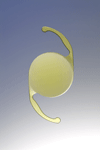Our Services  Cataract Surgery Process
Cataract Surgery Process  What is Intra-ocular Lens?
What is Intra-ocular Lens?
What is Intra-ocular Lens?
An intraocular lens (IOL) is an implanted lens in the eye, usually replacing the extracted cataract, or as a form of refractive surgery to change the eye's optical power. It usually consists of a small plastic lens with plastic side struts, called haptics, to hold the lens in place within the capsular bag inside the eye. Nowadays, IOLs are made of flexible materials like Acrylic and Silicone. Most of them are fixed monofocal lenses matched to distance vision. However, other types are available, such as multifocal IOLs which provide the patient with multiple-focused vision at far and reading distance, and accommodating IOLs which provide the patient with some visual accommodation.
Monofocal Lens Implants
Presbyopia-Correcting Lens Implants

Presbyopia is the natural age-related loss of flexibility of your lens to focus from far to near or vice versa, requiring you to use reading glasses, bifocals or multifocals spectacles. Moreover, cataract surgery itself also induces presbyopia since your own accommodating lens is removed.
An intraocular lens (IOL) is an implanted lens in the eye, usually replacing the extracted cataract, or as a form of refractive surgery to change the eye's optical power. It usually consists of a small plastic lens with plastic side struts, called haptics, to hold the lens in place within the capsular bag inside the eye. Nowadays, IOLs are made of flexible materials like Acrylic and Silicone. Most of them are fixed monofocal lenses matched to distance vision. However, other types are available, such as multifocal IOLs which provide the patient with multiple-focused vision at far and reading distance, and accommodating IOLs which provide the patient with some visual accommodation.
Monofocal Lens Implants
- Basic Lens:

A Basic Intraocular Lens Implant is a fixed single focus lens that is designed to improve vision at just one distance, either far or near. The potential drawback is that after surgery you will probably need to wear glasses for near or far vision, even if you have never worn any glasses before surgery.
-
Toric Lens:

Many people have some degree of astigmatism (oval shaped cornea instead of the round shape), but a minor level of astigmatism is considered normal and requires no correction. For patients with moderate to high degrees of astigmatism, you can choose to have your astigmatism permanently reduced by having a Toric Lens Implant, but still, you will need to wear glasses for near or far vision.
Presbyopia-Correcting Lens Implants

Presbyopia is the natural age-related loss of flexibility of your lens to focus from far to near or vice versa, requiring you to use reading glasses, bifocals or multifocals spectacles. Moreover, cataract surgery itself also induces presbyopia since your own accommodating lens is removed.
- Multifocal Lens: Multifocal Lens Implants are manufactured with very fine rings with multiple powers. so you can see well at far and near focusing points. They do not require any muscular activity in your eyes for focusing, but a period of adjustment is necessary to learn to use this new optical system. The compromise is that there is a greater chance of seeing halos or rings around lights, glare and unclear vision as compared to a basic monofocal lens. Over time most people get accustomed to these disturbances and less prone to notice them, while others may continue to notice them long after surgery. You may have some difficulty distinguishing an object from a dark background, especially in areas with less light. You should take extra care when driving at night. Toric Multifocal Lens ar also available to correct astigmatism at the same time.
- Extended Depth of Focus (EDOF) lenses have an elongated focus and a deeper depth of vision than conventional monofocal lenses. It achieves satisfactory far and intermediate visions, but the near vision is weaker than multifocal lenses.
